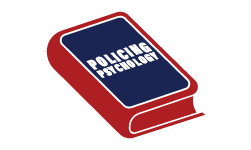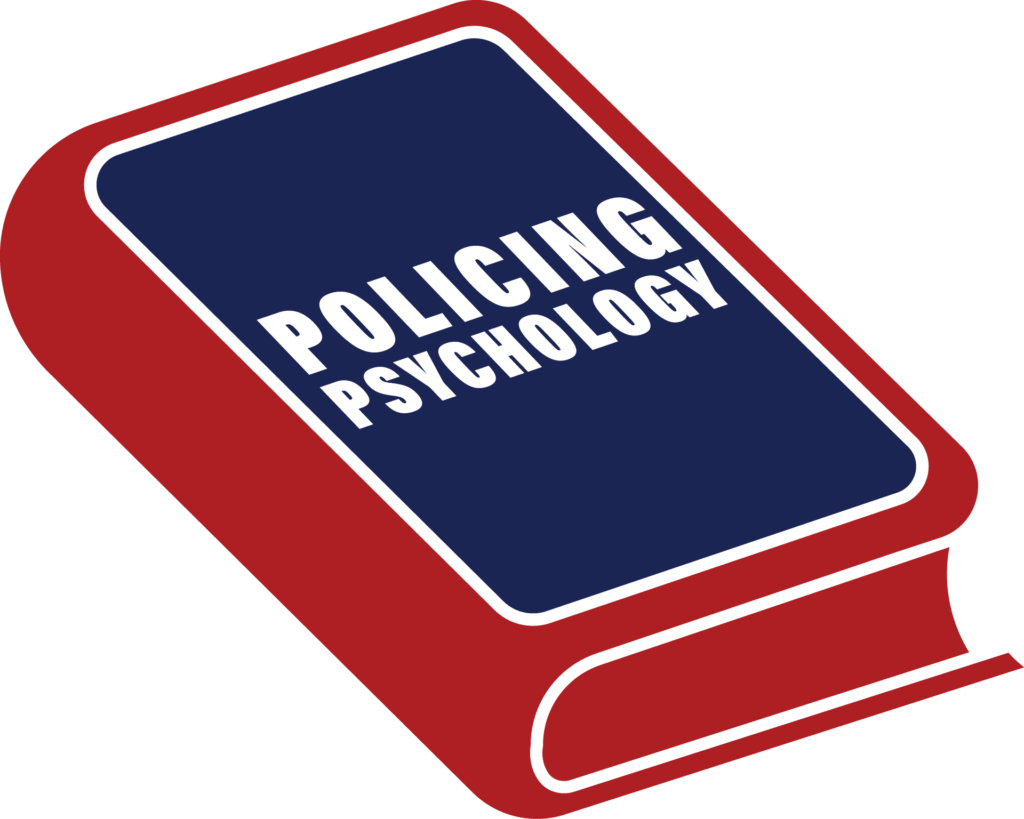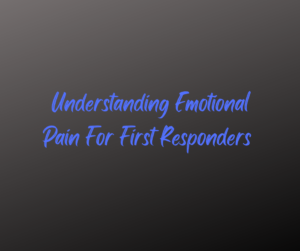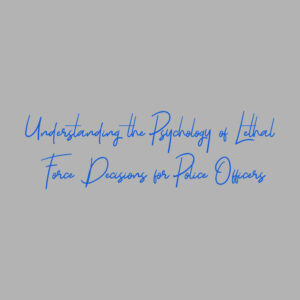Blogs
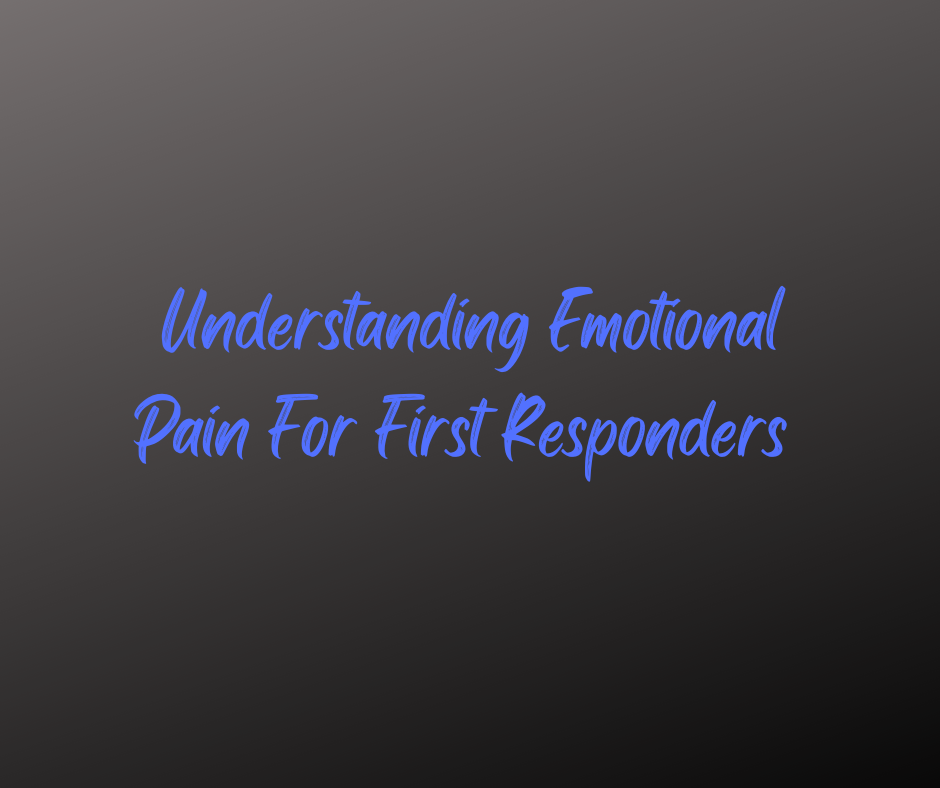
Understanding Emotional Pain For First Responders
“Unexpressed negative emotions never die. They fester like an infection, and they become cancerous.”-Former FBI negotiator Chris Voss, author of Never Split the Difference, speaking during his Masterclass series.
I walked into the victim services office to make a referral for a sex assault of a young victim. I have done this many times during my career, but this time was different. I wanted to make sure that the victim was well supported. I couldn’t change what had happened, but I wanted to ensure that they had the best possible support available.
I provided a summary of the investigation to Cheryl, along with the necessary contact information for the victim and the family. I turned around and started to walk out of the room, when Cheryl said to me, “Mark, that was a terrible call. What are you going to do to take care of you?”
I had stayed professional throughout the call. I had learned to compartmentalize my feelings. However, when Cheryl asked me that question, I didn’t even have time to think of what to say. Honestly, I just started to cry. I’m not talking just a tear running down my face. The emotional pain that I had managed to hold in hit me hard. I was trying to hold it in. I just couldn’t anymore. So, I let it out for a few seconds. Then I took a few deep breaths, I got control of myself. I thanked Cheryl for thinking about me and I went back to finish writing my report.
This feeling didn’t end in that moment. I went home that night and talked to my wife about it as I was still upset about the call. I talked with some friends, other police officers who understood the emotional pain of calls. They could listen and understand. This helped so that I didn’t need to carry it around by myself anymore. It helped to let go of that pain.
UNDERSTANDING DOESN’T CHANGE BIOLOGY:
This call happened after I had already written a chapter for my upcoming book about empathy and emotional. I already knew that we feel emotional pain in a part of our brain called the insula, which is the same region of the brain that feels physical pain. Even though we can’t see the emotional pain like a physical injury, our brain can still feel intense pain of our emotions. It is just a as real as physical pain.
I understood that empathy was a natural part of being a healthy person. It allows us to bond with others. We need it. We do this not only by understanding other people’s emotions. We do this through feeling their emotions. Even when it’s their pain that you’re feeling. Even if you don’t want to feel it. You still do. I still felt that pain. My logical understanding of the topic didn’t change my immediate emotional reaction to the extreme suffering of an innocent person.
I used to judge myself for that kind of reaction. I used to think “what the hell is wrong with you?” I used to think that having feelings was weakness. I thought that something was wrong with me for having an emotional reaction after experiencing the extreme suffering of others. I don’t anymore. I honestly don’t care one bit if someone wants to judge me for a having a human reaction to someone else’s suffering. That’s their problem with how they see the world. It’s not my problem for how I feel. They have a dysfunctional mental model about emotions, and I won’t let them put that onto me.
It probably took me at least a decade of police work before I was able to really look at my own mental models and to replace the ones that weren’t working for me. I think most of us start our careers with a mental model that “cops don’t cry” or “real men don’t cry.” Where does it get us? For some of us, we bury some of that emotional pain deep down. Then we judge ourselves for truly feeling it and then we continue to carry it around for years. This can often mean that we carry it around with us for years without even trying to process it. Or maybe we can learn how to turn off our emotions? But how does that impact the rest of our lives?
If you are trying to shut off your emotions, then how do you show up with your family when you’ve lost your ability to connect with others? What if there was another option? What if you could find a mental model that was more accurate to reality? What if it helped you to let go of some of the emotional pain?
UNDERSTANDING MENTAL MODELS:
Mark Twain said, “it ain’t what you don’t know that gets you into trouble. It’s what you know for sure that just ain’t so.” This is true for our mental models of emotional pain. We are often socialized to think that feeling or expressing our emotions are a sign of weakness. It isn’t. It comes with being a person. Continuously piling on more emotional pain without attempting to resolve the pain is a plan that involves a lot of on-going suffering. You’re a person first and a first responder second. You can’t override your biology because it doesn’t line up with your broken mental model. I write about the change in my mental models in my chapter on stigma (click here for stigma chapter).
JODY CARRINGTON’S ADVICE:
In my chapter on emotional pain, I describe a tragic fatal vehicle crash that I attended, along with a devastating next of kin notification. I carried that pain around with me for years. I couldn’t talk or think about that call because it would make me break down crying, so I just avoided it. I kept adding on more pain from new traumas. I didn’t resolve any of them. Until that backpack full of pain weighed too much and I couldn’t carry it around anymore. One day I heard some good advice from Dr. Jody Carrington, who said words to the effect:
“That pain that you’re carrying around. You don’t have to carry it anymore. You can leave it right here in my office. I don’t even have to pick it up. It can just sit right over there in the corner.”
It’s the truth. It won’t always be easy but it is possible.
The first step is to choose the courage to confront the pain, so that you can try to let it go. You can find more about Dr. Carrington on her website at www.drjodycarrington.com.
There are different options that you can try if you are experiencing on-going emotional pain. First off, we need to normalize getting help from a psychologist or counsellor. It was hard for me to break through my own stigma around seeing a psychologist. I conducted interviews with cops during my research project for my Master’s Degree and I was shocked at how many officers also felt a similar stigma about seeking help. One of the most powerful things that we can do is to reduce the stigma by normalizing the experiences that we have. This reduction in mental health stigma is called for by the 2019 Ontario Coroner’s Review in police suicides, as needed in policing on an urgent priority basis. As the famous psychologist Viktor Frankl wrote, “abnormal reactions to an abnormal situation is normal behaviour.” Talking about these experiences helps others to handle them in the future by reducing the stigma around them.
Journaling about my painful experiences was also an important step for me. I have heard many high-profile psychologists describe the benefits of journaling for relieving long-term emotional pain. Writing down my thoughts and feeling about painful experiences helped me to release the pain that I had experienced for years. If you are experiencing continued emotional pain from traumatic experiences, I would consider asking your psychologist about if it might help you?
Sleep is another thing that can help us. To paraphrase sleep expert Matthew Walker, it is not time that heals all wounds but rather time in REM sleep. This is because sleep is crucial for our memory in two ways. We need REM sleep so that we can remember the things that we need to remember but we also need it to forget the things that we need to forget. This includes forgetting trivial things like where you parked yesterday and traumatic memories that you want to forget. I’ll provide some more information on sleep in an upcoming blog post.
DIVIDE THE PAIN:
In his book On Killing(click here for summary), Lt. Col Dave Grossman says, “pain shared is pain divided.” Similarly, Kevin Hynes, a well-known suicide prevention advocate who survived his own suicide attempt after jumping off the Golden Gate Bridge said, “pain shared is pain halved.” I think that is likely one of the roles of empathy. It’s that we evolved to help each other cope with the pain and hardships of life.
WHAT DID THAT ACTUALLY LOOK LIKE FOR ME:
I came home and I talked with my wife about this call. I was still upset but it helped to speak with her about it. I also talked to some of my close friends about it. The ones that I knew would ‘get it’. The people that I knew would listen. The people who I knew had been through it before. When you’re in that spot, you don’t need someone to fix your problem. You just need someone to listen. You just need someone to care.
SUPPORT – MESSAGE SENT VS. MESSAGE RECEIVED:
We often don’t know what to say to someone when they’re going through a hard time. I’ve been there, where you type a message and then delete it so that you can start again because you just can’t find the right words. But here’s the crazy part about that. It almost doesn’t matter what you put in the message. Just sending a message lets them know that you care. There is a difference between the message sent and the message received. Let me show you what I mean:
The next evening, as I was getting ready for work, I got the following text message from Jordan. It read, “hey bud I was thinking about your call the other day. Tough one. Just wanted to say I’m thinking about you and hope you have a great shift.” That was the message sent but the message that I received said:
“I care about you”
“You’re not alone”
“I’m here for you.”
It was dividing the pain so that I didn’t have to carry it around all by myself. Together we can support each other, so that we choose more healthy coping strategies to manage the pain. For a long time in policing, the answer to unbearable emotional pain was alcohol, and often lots of it. Consuming lots of alcohol will only make things worse in the long run for several reasons. It’s bad for your brain health. It’s bad for your sleep. Having social drinks is fine but choosing alcohol as your primary method of coping with emotional pain is not a good long-term strategy.
IN PERSON SUPPORT:
Providing someone with support doesn’t need to be in writing. It can be just as effective or even more so, in person. I remember one night when my friend Catherine had been on scene for a terrible fatal collision. She then had to tell a family that their loved ones had died. I had been through that pain before. I knew how hard it was. When I saw her, I didn’t need to say anything. I just gave her a hug.
It’s something so simple but also so powerful. It’s having chemical changes within your body that you can’t see. Most of us don’t understand the important increases in chemicals like oxytocin or serotonin. We don’t need to. We only need to know that it works.
THE POWER OF A SUPPORTIVE NETWORK:
Dr. Van Der Kolk wrote The Body Keeps the Score (click here for summary), which is a book that helped me to understand and process trauma and emotional pain. Dr. Boessel Van Der Kolk wrote that a supportive network is the best protective factor for our recovery from traumatic experiences. I had a great support network,which is a part of why I was able to heal from my traumatic experiences. We can learn to better understand trauma, stress and emotional pain, so that we can help ourselves and each other to move forward from those experiences.
Every first responder needs to learn about trauma, so that we can process the trauma and emotional pain that we will see. The first time that I read The Body Keeps The Score, I had moments where I would say out loud, “that was me.” It helped me to understand my experience. It helped me to understand what was happening in my own mind. It also helped me to understand some of the scientifically proven treatment methods that we should be learning about.
VICARIOUS TRAUMA:
There are terms for experiencing trauma through the experiences of others, such as vicarious trauma and secondary trauma. If we can learn to understand these concepts, we can also learn how to process those feelings, so that we can let go of the negative emotions.
I still remember the traumatic events that I have experienced. However, I don’t remember them with the same emotional load that I used to. Just like the call at the start of this post, I was able to let go of that pain and to leave it there on the floor, just like Dr. Carrington suggested. We don’t get to decide what happens to us, but we get to decide on what we do from there.
UNDERSTANDING EMOTIONS:
If you would like to gain an advanced understanding your own emotions, you can check out my book summary of Lisa Feldman Barrett’s book How Emotions Are Made (click here for summary). She is an award-winning researcher who studies emotions and the brain. Her book changed my understanding of emotions. She provides great insights into emotions, including sharing some of her own emotional experiences. She describes her experience of crying after hearing some terrible news. Despite being a researcher about emotions who understood it was her body’s reaction to calm her nervous system, she still experienced the emotions. Just like all of us do. This is one of the most important points, understanding these concepts won’t make you immune from feeling emotions but they can help you to process and move forward when you experience them.
SUMMARY:
As police officers and as first responders, we will encounter traumatic experiences, which include witnessing the pain and suffering of others. We are biologically wired to feel the pain of others because of empathy, which is important for our ability to connect with others. We can find healthy coping strategies to help us process, express and reduce this emotional pain. As Dr. Carrington wrote, we don’t need to keep carrying it around. We can use scientifically proven treatment methods to try to let it go.
Our support networks can be our greatest asset to let go of that pain. We can share how we feel, to allow ourselves to process the feelings, so that we can move forward from them. Those support networks can help us to do that by listening empathetically and by sharing messages that make us feel supported and understood.
You will not get to choose what happens to you, both at work and in your personal life. We will all experience some forms of loss, pain and suffering in our lifetimes. We will get to choose how we respond to these challenges. We can learn to choose healthy coping strategies, that help to support each other through the hard times.
As the quote from Chris Voss says at the start of the chapter, “unexpressed negative emotion never dies.” I was afraid to confront my emotional pain for many years and I continued to suffer from it. Once I was able to work at letting go of that pain, it got better. If you’re carrying around emotional pain, maybe you can too?
Recommended reading:
